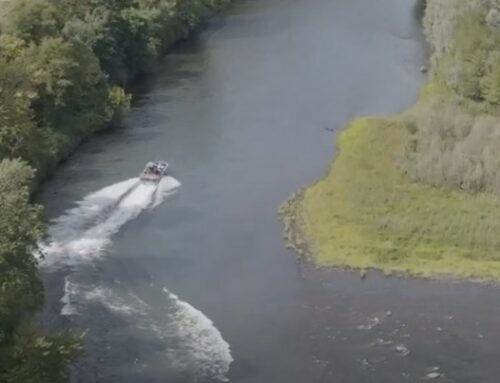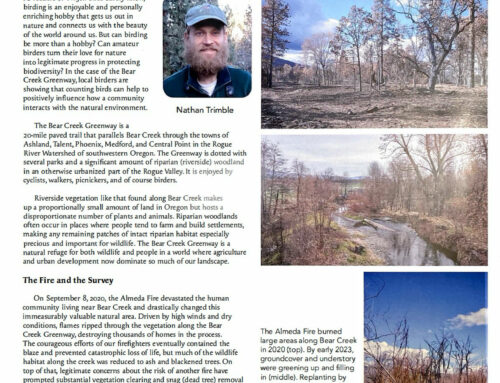The Oregon Department of Fish and Wildlife, as part of their on-going efforts to implement the Oregon Conservation Strategy, has identified a project to restore fire to approximately 120 acres of Oak Woodland and mixed conifer habitat in the Applegate Wildlife Management Unit.
Following the presentation by Steve Niemela of ODFW at our members’ meeting in February, we have been interested in finding conservation and habitat enhancement projects that ODFW and RVAS can work on together.
Here’s how Steve Niemela describes this project:
The Oregon Conservation Strategy, the State of Oregon’s blueprint for the conservation of at-risk species and habitats, has designated Oak Woodlands and savannahs as one of the 11 most imperiled habitats in Oregon. In the Willamette Valley and the Coast Range, 95% of historic oak habitat has been lost to development and agricultural conversion. Oaks in our Klamath Mountain Ecoregion are relatively more abundant, but still threatened. Forty-five percent of the Oregon White Oak habitat in the Rogue Basin has likely been lost over the last 100-150 years, and remaining oaks are threatened by our history of fire suppression.
Oak Woodlands and savannahs are fire-adapted ecosystems which rely on relatively frequent but low intensity fire to cycle nutrients, eliminate competing conifers, thin stands, create the cavities, snags, and down wood needed by wildlife species and rejuvenate the shrub layer. Historically, fire returned to these oak systems every three to 20 years. The absence of this low severity/high frequency fire has resulted in oak stands that are not providing the habitat they could for wildlife species and are in danger of loss from catastrophic wildfire or conversion to a Douglas fir stand. These new conifer forests are not adapted to the specific site, and in recent years, they have proven vulnerable to drought and insect pests in the Applegate, setting the stage for more severe wildfires.
Loss of natural disturbance has set the stage for a new type of relatively infrequent but high severity fire that is outside the range of historic variability and has the potential for stand-clearing events. Cli- mate change is likely to exacerbate this threat as temperatures rise and precipitation becomes less predictable. The Oregon Conservation Strategy defines the loss of natural disturbance such as fire and global climate change as two of the key conservation issues threatening species and habitats across Oregon.
The Southern Oregon Forest Restoration Collaborative has recognized the reestablishment of fire as a critical strategy in restoring ecologically resilient forests. SOFRC identifies 2.1million acres on federal land that are accessible and in need of treatment in the Rogue Basin. One million acres of these are not economically self-sufficient and will require subsidy to achieve goals of ecological restoration and fire resiliency. Current funding and scope of operations is not keeping up with the demands of an increasing fuel load, degrading oak habitat and encroaching conifers.
ODFW proposes to maintain approximately 120 acres of previously treated oak and mixed conifer habitat through the use of a prescribed fire underburn on BLM property within the Applegate Wild- life Management Unit. We will hire contract crews to conduct the burn in the fall. Fall burning is more consistent with the area’s fire history and avoids problems with burning in the biologically active spring season when new wildflowers are blooming and wildlife are reproducing.
BLM has suggested a site for this potential oak restoration project. It is about two miles west of Cantral-Buckley Park, on the south side of the Applegate River. The site includes approximately 40 -50 acres of an open Oregon white oak dominated woodland and about 80 acres of a mixed conifer hardwood stand dominated by Douglas Fir, with madrone, black oak, and big leaf maple scattered throughout. The site was thinned during the Pilot Joe project and is in need of an under-
burn. Portions of the site are within the Nature Conservancy’s areas of modeled oak persistence and is relatively close to ODFW’s Oregon Caves/Applegate Conservation Opportunity Area.
ODFW has acquired a $12,500 grant from the Oregon Wildlife Foundation, which it is using as match to secure an additional $37,500 from the Pittman Robertson grant, a federal excise tax on firearms that is used for wildlife management. Rogue Valley Audubon has agreed to signal our sup- port with a small monetary contribution, and to help organize citizen science volunteers to conduct bird monitoring before and after the prescribed burn. Photographs of the site indicate that there is relatively little brush present that would be attractive to nesting birds, and the burn will probably mostly clear out invasive conifer saplings that could eventually crowd out the oaks on the site, cycle nutrients, create fire scars or cavities that are important to wildlife, and make the forest as a whole more resilient to fire in the future. Therefore, prescribed fire will likely benefit the oak woodlands, but it would be very desirable to have monitoring to document the effects on bird populations.
WHAT YOU CAN DO: If you’re interested in participating in bird monitoring for this project or want to find out more, please contact Steve Niemela at ODFW, who will keep you informed as the project moves forward. His email is: steve.a.niemela@state.or.us. Applegate residents are especially en- couraged to participate!
May 2017 Conservation Column by Pepper Trail






Leave A Comment
You must be logged in to post a comment.